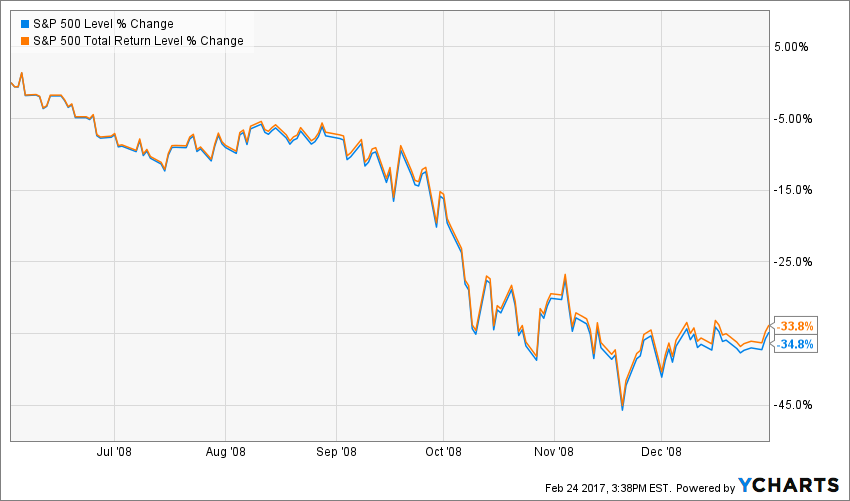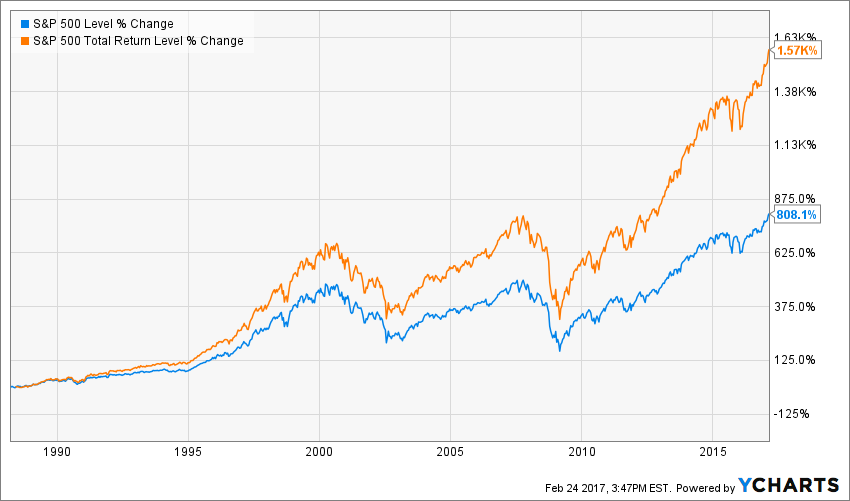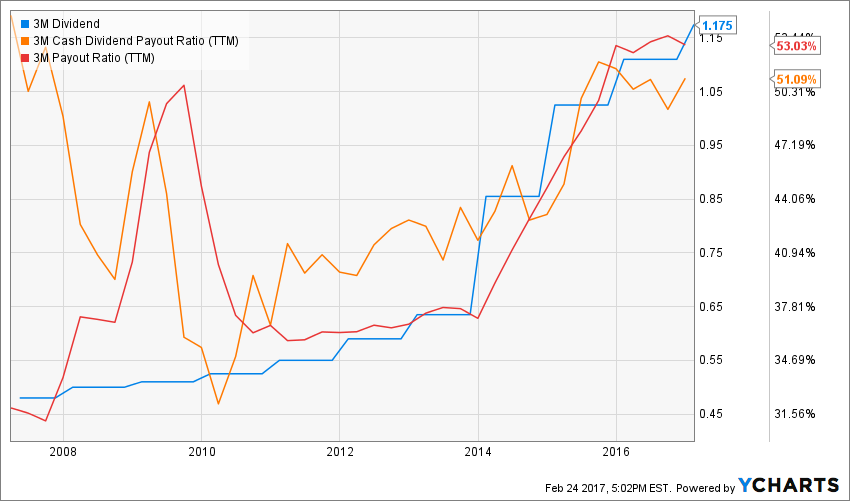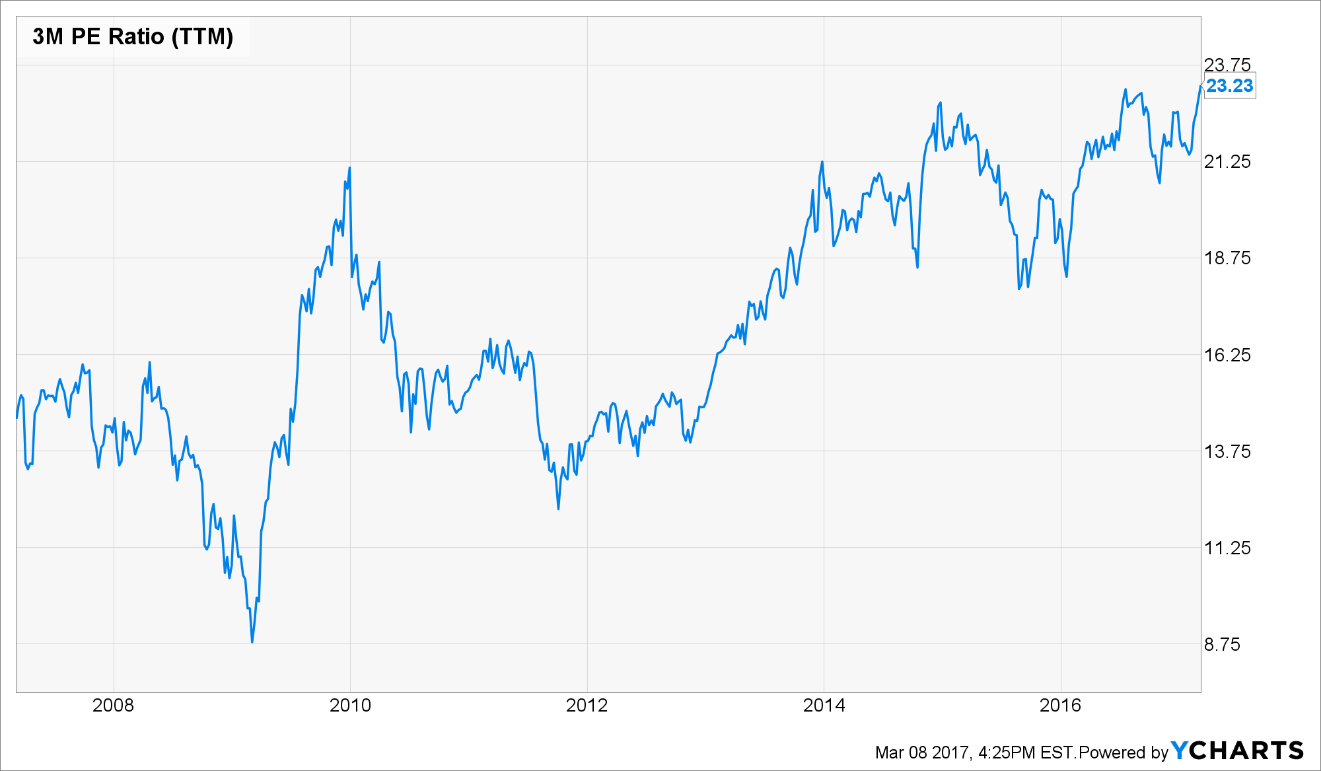Between 2009 and 2017, the market went up on one of the most amazing streak:

Source: Ycharts
As you can see, for an investor waiting on the side lines, he had 2 very little opportunities (one in 2011 and one in 2015-2016) to enter the market during a plateau. Even then, the best timing to enter the market has always been today and the worst has always been tomorrow. This article will go in-depth to explain you why and how to invest an important amount of money in today’s stock market.
Still, the question of timing to invest your money is being recurrent among all investors. The reason is quite simple, nobody wants to invest in a stock market that will go bust the next morning:

Source: Ycharts
Are you willing to lose 35% of your money in 6 months just because the “right timing is now”? I totally understand you would not. We are all afraid to lose money when we are about to invest a big amount.
If you want to invest a massive amount of money and you are paralysed by the fact the market is too high, there is a solution. Just keep reading…
The market is a dangerous place
“Investing should be more like watching paint dry or watching grass grow. If you want excitement, take $800 and go to Las Vegas.”
– Paul Samuelson
As I just mentioned, nobody wants to invest right before a bear market or worse, a market crash. This thought alone can paralyse your money for months, read years. When you get your eyes stuck on the screen, the market can become a dangerous place. However, one must first remember he doesn’t invest for the next 3 to 6 months. An investor should think about the next 30 to 60 years. This is why we should look at a graph with perspective, like this one:

Source: Ycharts
Lesson learned from this graph: the stock market always go back up. This graph covers pretty much all catastrophes an investor could live in his life. After the techno bubble and a credit crunch, the stock market is still averaging around 10% annualized returned over the past 30 years. I hope you have realized that I’m using total return in all my graph as dividend growth investing is the backbone of my investing strategy.
When you are in for the long haul, how the stock market will react in a few months should not worry you. The certainty you need is that the stock market always go back up. If you are not in for the long haul, then maybe investing in the stock market is not for you.
Unfortunately, being in for the long haul, is highly profitable, but incredibly boring…
The market is at its all-time high – how do I invest?
“The four most dangerous words in investing are: ‘this time it’s different.’”
– Sir John Templeton
Now that we have agreed that the stock market will reward its patient shareholders, investing when the market is at an all-time high is still not easy. Chances of making investment mistakes in 2017 are greater than making one in 2009 for example. This is mainly because we have been riding a 8 years long bull market. In fact, I could have given 100K to my 11 year old son in 2009 and he would have made money. I’m not too sure I would trust him to make investment decision in 2017.
The thing with a strong bull market is that it hides many bad companies. It like the ocean high tide; everything, good or bad, is being lift up to the top. Now, you have money to invest and you surely don’t want to pick-up someone else’s garbage.
On the other side, the only worse decision than picking bad stocks would be to not pick any at all. How’s your money market fund did between 2009 and 2017? What can save you is a strong investing process. With a well-defined stock picking methodology, you can start building a new portfolio today and invest a lot of money without being stressed even if you start in a all-time high market. The methodology presented above has been based on decades of academic studies and based on my own experience.
Don’t expect the market to be different this time. It will go down, and will bounce back. The only thing we don’t know is when. By using a stock selection process rigorously, you can start investing today, even if “today” the market is high. The following process will help you doing it the right companies and avoid picking bad ones.
#1 General metrics to filter down your research
“An investment in knowledge pays the best interest.”
– Benjamin Franklin
It is virtually impossible to screen the entire market and look at every single dividend paying stock for a single investor. This is why stock filters have been invented. But then again, with a complete access to all kind of data, the number of searches and theories on fundamentals are endless. How could you select efficiently a smaller bag of companies without losing all your time playing around with you filters? ‘Cause trust me, you can spend months playing around with fundamentals without picking a single stock.
I personally like to keep things simple. I don’t go too far with playing with stock filters as I believe numbers are only one part of the answer. In fact, no matter how great numbers a company could show, it only shows what it did previously, not what it will post in the future.
I have a few variations of filters, but it usually goes along the following lines:
- 50% < Dividend Yield (TTM) < 5.00%
- 01% < Dividend Per Share (5 Year Growth) <
- 01% < Dividend Per Share (3 Year Growth) <
- 01% < EPS Diluted (5 Year Growth) <
- 01% < Revenue (5 Year Growth) <
- 01% < Revenue (3 Year Growth) <
- 00% < Payout Ratio (TTM) < 100.0%
- 00% < Cash Dividend Payout Ratio (TTM) < 150.00%
I use the powerful stock screener provided by Ycharts. It helps me getting into details fairly quickly. Those filters are applied to both Canadian and US market. It will provide between 250 and 300 searches. While this makes a huge basket of stocks to pick from, I like to have variety!
Those metrics enables me to select companies with crucial trends for dividend growth investors; growing revenues and earnings. It all comes down to this: if a company doesn’t grow their revenues, it can’t grow their earnings. And if it can’t grow its earnings, well, what do you think will happen to the dividend payment?
Payout ratios and cash payout ratios are used to determine if the company is about to suspend its dividend raise or if there is still room for management to keep being generous. After all, the power of compounding dividend lies within consecutive payment hikes.
A while back, I used to select companies paying over 2%, but I tend to give a quick look at lower yielders now. I’ve found gem such as Apple (AAPL), Disney (DIS) and Canadian National Railways (CNR.TO or CNI) by opening my search a little. I also rarely consider companies paying over 5% yield. They are usually in danger… especially when you are at a all-time high on the market. Why in the world a company would pay over 5% yield when interest are at their lowest and valuation is at the highest? There is only one answer to this question: because the company and its dividends are in great danger. Remember I told you that high tides bring everything up? Most 5%+ yielders are garbage.
Such filter will bring about 250 to 300 stocks on the table. This is too much for any kind of portfolio. Keep in minds that even professional portfolio manager with a complete team of analysts owns about 40 stock per portfolio. Once this first filter is done, you can start by looking at each component individually and consider the stronger dividend growth stocks or the higher yield, depending on what you are looking for.
I personally try to find a balance between revenue, earnings and dividend growth metrics. If the three metrics are growing accordingly, then, I know the management has similar objectives than mine: increasing my quarterly pay checks. I don’t give much importance to dividend yield for the reasons explained above. I rather focus on future growth instead.
To finalize my search, I usually filter those results and try to find companies showing good numbers in all metrics. This is how I usually narrow down “my stock universe” to about 100 companies. At Dividend Stocks Rock, this is about the number of companies we follow.
#2 Test the dividend sustainability
“How many millionaires do you know who have become wealthy by investing in savings accounts? I rest my case.”
– Robert G. Allen
The next step of selection is all about dividend growing payments. There is no point of investing in dividend stocks if there isn’t growth. Why? Because inflation will eat-up your dividend checks if they don’t grow accordingly!
To do so, I like combining the dividend payment with payout ratio and cash payout ratio on a 10 year history graph:

Source: Ycharts
This is 3M (MMM) graph from 2007 to 2017. As you can see, dividend payment has been consistently raising and so the cash payout and payout ratios. There are three observations to make from this graph;
- #1 The company is seriously committed to increase dividend payouts
- #2 Management benefit from lots of room for future increase (payout ratios around 50%)
- #3 It will be impossible for the company to maintain the aggressive dividend hike policy it has since 2014 as the payout ratios are rising just as fast as the dividend.
Testing dividend sustainability enables me to make sure that the company you are about to select for your portfolio will continue increasing its dividend in the future. If payouts ratios are around 90% or more, then, it’s time to ask yourself serious questions about the future dividend payment. If you can answer how the company can control this situation and increase their earnings in the future, there is no problem at selecting a higher payout ratio stock. However, if you are uncertain about how earnings could rise in the next 5 years, then you have little hope to see steady or significant dividend raise. You must remember that management will not throw away important cash flow to shareholders if this hurt the company’s balance sheet. If they do, this is just another reason to not pick up this stock!
#3 Define the business model and advantage
“The individual investor should act consistently as an investor and not as a speculator.”
– Ben Graham
Once you have played enough with fundamentals, it’s time to look forward into the future. This Jedi skill can be learn with a simple process: define the company business model and highly their main strengths.
In general, the company business model will tell you how numbers will go facing a recession or riding a strong economy. It is also very important to understand how the company makes money before you buy its shares. For example, I don’t know much about the mining industry and how they figure the future price of their commodity. For this reason, I’m staying away from such companies (plus, they are usually bad dividend payer anyway!).
On the other side, I completely understand how Disney (DIS) makes money. They sell entertainment and dream for all family members. Over the years, they have built a strong model where they can first make money from movies (Star Wars, Marvel’s, Frozen, etc) and then, create an incredible variety of money drivers (through their theme parks, toys, cruises, clothes, etc). Their main strength resides on their ability to create near to infinite cross selling opportunities with a single product. They have the marketing budget and the experience to establish efficient strategies making almost every movie a billion dollar industry by itself.
Once I clearly understood what Disney business model is about, I can understand how the company will evolve in all kind of economic situation. Can Disney exist in 50 years from now? Can it continue paying an increasing dividend? What possible catastrophe could affect Disney over a long period?
#4 Write down your investment thesis
“Know what you own, and know why you own it.”
– Peter Lynch
Writing down your investment thesis is the most important part of any investing process per my opinion. Funny enough, this is also the most overlooked part by many investors. I know, writing down stuff makes you work and takes additional time. But this is a crucial step that will make you a lot of money, and most importantly, will make you save lots of money as well. Why? Because defining the reason to buy a stock will, by default, determine the reason to sell it as well.
For example, I used to own Wal-Mart (WMT) in my portfolio. My investment thesis at the time of the purchase was the following:
Wal-Mart is a leader in retail stores. The company manages stores across the world and benefits from geographic diversification. Management has built a strong brand name and WMT sizes enables substantial economic scales making it very hard for competitions. Since WMT sells “everyday stuff”, they are not at risk during a recession as their base of costumers will continue to make basic purchases. The company is now moving lots of capital to build a strong and reliable e-commerce site. I believe the future of WMT will go through internet sales. Their experience in brick-&-mortar stores and selling goods should be enough to conquer this new playground. The company shows steady revenue and earnings growth. Finally, WMT is a dividend aristocrat showing over 25 years of dividend increase.
Now, what has made me sell WMT? It does sound a buy-hold-forever stock right? The thing is that Wal-Mart failed at one key element of my investment thesis; after several years, they are still a minor player in the online commerce industry leaving Amazon (AMZN) setting the rules on this new playground. WMT didn’t cut or suspend its dividend growth, but I don’t see in 5-10 years from now how management will be able to increase their dividend. Since WMT doesn’t meet my investment thesis, I sold the stock in 2016. This is as easy and simple as that.
I am very well aware I might be wrong in my investment thesis. The purpose of writing it down it not to be flawless. The purpose is to know why you buy a stock so you can sell it and move along quicker if it fails you. This avoids having everlasting doubts paralyzing your money for months or years.
#5 Determine the right valuation
“The stock market is filled with individuals who know the price of everything, but the value of nothing.”
– Phillip Fisher
Ah! After many hours of research, you finally find the exceptional company you were looking for. But before you pull the trigger and buy 100 shares of it, the question that kills:
Is this stock overvalued?
The answer to this question is very hard to give, especially when the market is trading at a all-time high. However, my short answer to this question is quite simple. If you have found an exceptional company, today is the best timing to buy it and tomorrow is the worst one. I know you will probably won’t bite this as most investors prefer finding a complete process to assess the value of a share. The reason why I use a valuation process is mainly to determine what is the best buy among my short list of exceptional companies. I use a simple two step valuation process.
The first step is to look at the company’s PE ratio history of the past 10 years. Over a 10 years history, you usually get how a company’s valuation by the market evolves through a complete economic cycle (facing both recession and strong growth periods). Here’s 3M (MMM) PE historical graph:

Source: Ycharts
At first sight, we can see that MMM has rarely been trading at such high PE ratio. It seems that the company is overvalued right now. Probably that investors are willing to pay a premium for a strong dividend growth company in an uncertain environment.
Then, I use a double step dividend discount model (DDM). The DDM gives me the fair value of a company considering solely its future dividend payment capacity. By using a two-step model, I’m able to use a dividend growth rate for the first 10 years, which would reflect the company current situation and near future and a terminal dividend growth rate usually reflecting a more conservative growth rate for the long haul. Here’s what it looks like:


As you can see, at the moment of writing this article, MMM seems slightly undervalued (current market price at the time of calculation was $189). I give more value to the DDM as I’m after the dividend payment when I invest my money. If the company met the rest of my investing process, this could be a strong candidate to my portfolio.
Here’s your next step
While this article is a good introduction on the topic, you may be left with questions such as:
- How do I build a whole portfolio?
- What about asset allocation?
- Are there safer dividend stocks than others?
- How do you find the dividend growth rate and the discount rate for the DDM?
Don’t worry, I’m not leaving you hanging there. I’ve wrote a complete book on building your dividend growth portfolio. The best thing is that it’s free!
This book went from 30 some pages to 135 master-class manuscript
You can now download 30 Days to Dividend Growth Investing, the second edition of my original book; Dividend Investing – How to Build a Money Making Machine. I’ve reviewed the entire book to create a unique resources that will help you building your portfolio step-by-step or improving your trading technique.
Finally, don’t forget this famous quote from Peter Lynch;
“You get recessions, you have stock market declines. If you don’t understand that’s going to happen, then you’re not ready, you won’t do well in the markets.”
– Peter Lynch
Disclaimer: I own shares of DIS, MMM, CNI.
